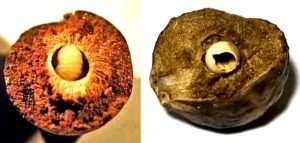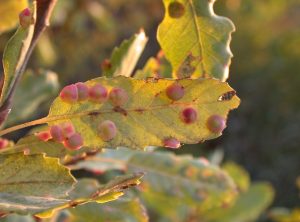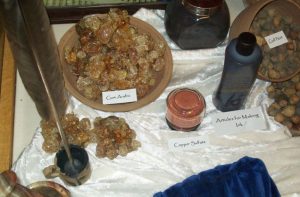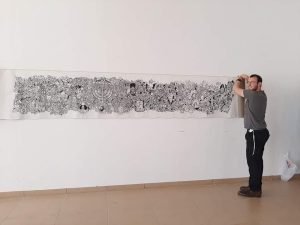For most of us, some items are so basic that we have never thought about how they are made. Pens and ink are in that category. But in ancient times (and up until very recently), nothing could be taken for granted. Everything had to be made and required not only technique but materials, usually from the natural world. Our Gemara mentions a valuable product that is a mystery to us today: עפצי, or gall nuts:
“Give me the six hundred dinars that I claim from you. The latter said to him: But didn’t I repay you with one hundred kav of gallnuts [עפצי] that were worth six dinars for each kav at the time?” (Shevuot 31b-42a)
What is a gall, an עפץ? A gall is a protective covering that grows on a plant after a parasitic invasion by an insect. The most common kind of gall is the one discussed here, the growth on an oak leaf. A wasp lays its eggs on the leaf. The tree, to protect itself, makes a hard growth around these larvae. The growth is good for the wasp, for the tree and for people. Once the larvae are grown, they break out of the growth, the gall, through a hole. The tree and the wasp have no more need for the gall but here is where human ingenuity steps in.

Gall with larvae and after larvae have grown and flown
Shkedi, CC BY-SA 4.0 <https://creativecommons.org/licenses/by-sa/4.0>, via Wikimedia Commons
Galls are rich in a material called tannin. Tannic acid is what plants produce to protect unripe fruit from being eaten before it has produced seeds. In practical terms, tannins are what make your mouth pucker up when you eat a fruit that is not quite ripe. Once the fruit is ripe, the tannin disintegrates, animals (or people) eat the fruit and spread the seeds. Tannin is useful to people as well as to plants. It can be used to preserve wine, it breaks down cholesterol in the blood (which is why people are advised to drink red wine) and it connects to proteins. This last fact is what brings us back to our Gemara. Tannin is used to process leather, which is why we call that process tanning. That is what Rashi explains here regarding the word עפצי:
“ ‘Gales’ in Old French, used to process skins” (Rashi to Shevuot 42a)
Tanned hides were used for klaf, the parchment that we write Torah scrolls and other sacred writings on. The Gemara in Menachot refers to hides that are tanned with gall and those that are not:
“Rather, those [sheets of parchment] that are not processed with gall [are labeled as old and cannot be sewn], those [that are processed with gall are labeled as new and can be sewn].” (Menachot 31b)

Galls on an oak in the Galilee
Gideon Pisanty (Gidip), CC BY 3.0 <https://creativecommons.org/licenses/by/3.0>, via Wikimedia Commons
The other product produced with gall nuts is something even more widespread than parchment: ink. The Mishnah in Gittin (2:3) lists various inks which may be used to write a get. Among them are Komos and Kankantum, as well as Dyo, ink. The Gemara adds an ink made with gall nuts:
“Rabbi Ḥanina taught: If he wrote it with . . . [water in which] gallnuts [עפצי] [were soaked], then it is valid,” (Gittin 19a)
What are these various ingredients and which ones make the best ink? Maimonides writes that the ideal ink is made of soot with various other ingredients added in. However, this ink is not a permanent one. He then adds that one can write also with gallnuts and kankanatom:
“This is the ink with which it is most preferable to write scrolls, tefillin, and mezuzot. If, however, one wrote any of the three with gallnut juice (מי עפצאי) and kankantom, which remains without being rubbed out, it is acceptable.” (Mishneh Torah Hilchot Tefillin and Mezuzah 1:3)
The two elements needed to make good permanent ink are gall nuts and iron sulfate, what our sources call kanakantom, a mispronunciation of a Greek word. They are each necessary and you cannot see one without the other:
“Rebbi Ḥiyya bar Abba said, those Orientals are very sophisticated. If one of them wants to write a secret letter to another, he writes with juice of gallnuts (מי מילין) The recipient pours ink without gall over it (דיו שאין בו עפץ,) which is absorbed at the place of the writing” (Yerushalmi Gittin 2:2)
The Korban HaEdah explains that writing with the gallnut juice does not show anything. Only when the iron sulfate is added does the writing appear. Ancient invisible ink!
The final component of the ink is called קומא, koma or komos. This is also a corruption of a Greek word, gum. The gum is the binder that makes the ink stay on the paper. Today iron gall ink is used mostly by Torah scribes but it was the most common form of ink in the Western world until the middle of the twentieth century.

The three components of scribal ink
Pete unseth, CC BY-SA 3.0 <https://creativecommons.org/licenses/by-sa/3.0>, via Wikimedia Commons
The rather esoteric names of the ingredients came to life recently in the context of a tragic story. Early in the current war, in November 2023, a gifted young artist named Eitan Rosenzweig fell in Gaza. Eitan was a brilliant young man who studied Torah, art, literature and many other disciplines. As an art major in high school he created an amazing final project. He titled it קומא, מי- עפעצים וקנקנתום; the names of the elements of ink. His work was ink on canvas and it was meant to illustrate the hero’s journey of the Jewish people.
Eitan’s work has a myriad of details and elements in it, encompassing Jewish history and ideas about the Jewish future. He chose the strange title because it connected to the sources but was foreign to most people, allowing the viewer to see the work without preconceptions. After Eitan’s premature death, his parents wanted to give this work the attention it deserves. Today it is displayed in the Bible Lands Museum in Jerusalem. May Eitan’s memory be for a blessing.

Photo courtesy of Chagit Rosenzweig










